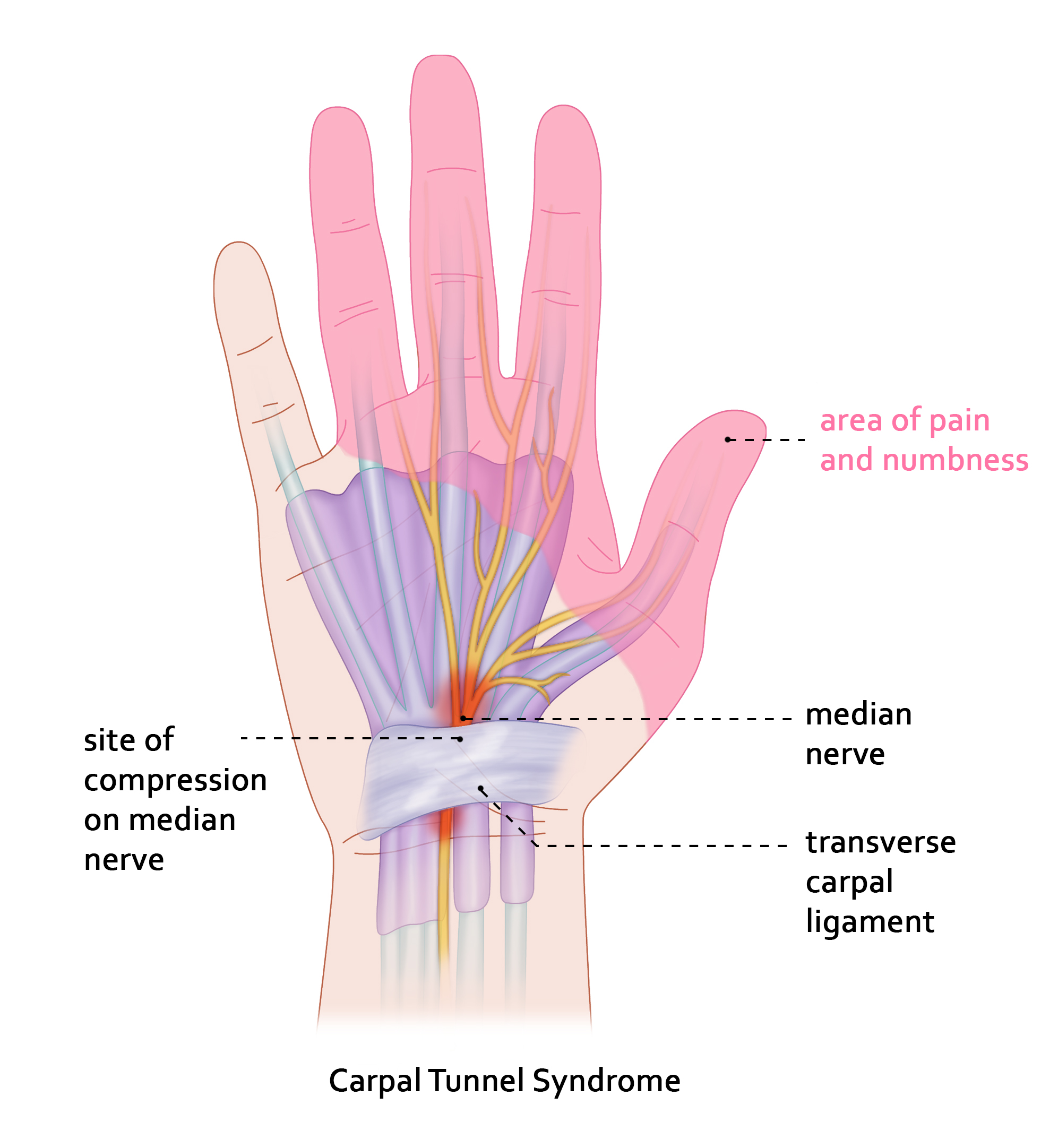Carpal Tunnel Syndrome
What is Carpal Tunnel Syndrome (CTS)
The carpal tunnel is a relatively small space in the wrist through which 9 tendons and the median nerve pass into the hand. Carpal Tunnel Syndrome (CTS) is caused by pressure on the median nerve in the carpal tunnel at the wrist.
What are the symptoms?
Common symptoms are pain in the hand and forearm, and tingling or numbness in the hand and fingers. The fingers may feel swollen and there may be weakness or clumsiness in the use of the hand.
Symptoms are often worse at night and may be relieved by shaking or dangling the hand out of the bed.
What Causes Carpal Tunnel Syndrome?
CTS generally develops between the ages of 30 and 60 and is more common in women, with a female-to-male ratio of 3:1. Although there are many possible causes, the cause is unknown in most people. There is some evidence that people who develop CTS have a smaller carpal tunnel, explaining why it may run in some families. Other possible causes include:
- Obesity – a good predictor of developing CTS
- Arthritis – inflammatory or osteoarthritis of surrounding joints
- Pregnancy – usually resolves after delivery
- Diabetes – or a family history of diabetes
- Trauma – recent or old
- Increased activity – including sport or work
Other medical conditions – underactive thyroid, kidney disease.
Is Carpal Tunnel Syndrome common?
Carpal Tunnel Syndrome (CTS) affects roughly 2.7% of the population. It’s more prevalent in women than men. The typical age range for those diagnosed is between 40 and 50 years.

Conservative Non-Surgical Treatment
CTS is usually managed by nonsurgical means initially.
This may give significant or complete relief, meaning surgery is not necessary.
Non-surgical treatments include:
- Activity modification
- Weight loss and exercise
- Splint – usually at night
- Steroid injection
- anti-inflammatory drugs
- Ice to reduce swelling
If symptoms persist and non-surgical means are not effective, then surgery is usually considered.
Carpal Tunnel Release Surgery
Carpal tunnel release surgery is performed to relieve the symptoms of carpal tunnel syndrome. Surgery to release CTS can be performed under general or local anaesthetic and is performed as a day surgery procedure in a hospital. At surgery, the transverse carpal ligament is divided. This is the ‘roof’ of the carpal tunnel and division of it creates more space, thus relieving pressure on the median nerve and releasing the carpal tunnel.
The surgery can be performed by either open or endoscopic (keyhole) technique. Results are generally the same for both procedures six months after surgery.
Recovery is quicker with the keyhole technique because it requires smaller incisions in the skin but not every patient is appropriate for keyhole surgery.
What happens post-surgery?
The wound usually heals quickly and symptoms are often relieved within the first few weeks. However, any altered sensation can take many months to recover if it was present night and day prior to surgery. The dressing is kept in place for 7-10 days post-surgery and patients can use their hands for gentle activities in the few weeks post-surgery.
The following may be advised postoperatively to aid healing and recovery:
- Physical therapy
- Wearing of a splint
- Ice packs to reduce swelling
- Keeping your wound clean and dry and wearing a plastic in the shower or bath.
FAQs
Is it important to treat Carpal Tunnel Syndrome?
If symptoms are mild, there may be no adverse outcome from no treatment. However, persistent and more significant symptoms may lead to permanent nerve damage, which can cause permanent loss of feeling and loss of function in the muscles that work the thumb.
Can I have keyhole carpal tunnel surgery?
Not every patient is appropriate for keyhole surgery. This will be assessed and discussed at your consultation.
What is the median nerve?
This nerve supplies some muscles that work the thumb, and give sensation to the thumb, index, middle and ring fingers.
What is the transverse carpal ligament?
The roof of the carpal tunnel.
What is open CTR?
The release is performed by making an incision in the palm.
What is endoscopic CTR?
When the release is performed by ‘keyhole’ surgery. 2 small incisions are made and a camera is used to guide the surgery.
Medical terms
carpal tunnel: A relatively small space in the wrist through which 9 tendons and the median nerve pass into the hand.
carpal tunnel release: Surgery to relieve the symptoms of carpal tunnel syndrome.
median nerve: Supplies some muscles that work the thumb, and give sensation to the thumb, index, middle and ring fingers.
transverse carpal ligament: The roof of the carpal tunnel.
open CTR: The release is performed by making an incision in the palm of the hand.
endoscopic CTR: When the release is performed by ‘keyhole’ surgery. 2 small incisions are made and a camera is used to guide the surgery.
Fees
Our Surgeons & Anaesthetists charge out-of-pocket fees for surgery done in the private hospital.
Because the length and complexity of the different surgical techniques are so vast, you will be given an estimate of costings after your consultation.
For more information on fees and rebates please visit the fee section on the FAQ page.

